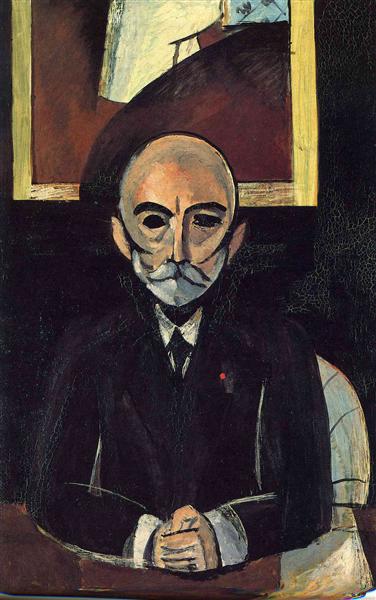Description
Henri Matisse, one of the most prominent figures of modern art and an undisputed master of color, offers us in his work "Auguste Pellerin (II)" from 1917 a unique representation of his style and vision. This portrait, measuring 38x60 cm, precisely encapsulates Matisse's ability to capture the essence of his subjects through a combination of simplified forms and a vibrant color palette.
The subject of the painting, Auguste Pellerin, was an influential art collector and businessman, known for his passion for acquiring Impressionist and Post-Impressionist works. Pellerin was a fervent admirer of Matisse, and the relationship between the two men was fundamental to the production of several significant works by the artist. In this portrait, Matisse eschews photographic detail to focus on a more emotional and symbolic interpretation of his figure.
Observing the painting, one can appreciate the austerity and solemnity of the character. Pellerin is depicted with a deep and reflective gaze, accentuated by his prominent eyebrows and the slight tilt of his head. Matisse uses a confident and relatively loose stroke to outline the shapes of the face, suggesting rather than defining the exact features of the subject. This approach highlights the character and personality of the portrayed more than his mere physical traits.
The monochromatic background is a wise choice that emphasizes Pellerin's figure without distracting the observer's attention. This technique creates a strong contrast with the face and hands of the portrayed, which are modeled with warmer tones and a delicate variation of lights and shadows. The simplicity of the background can also be interpreted as a reflection of the collector's seriousness, allowing his presence to dominate the composition.
Matisse, a pioneer of Fauvism, here renounces the explosion of bright and dissonant colors that characterized that movement, opting for a more restricted but equally expressive palette. The tones used in Pellerin's face are moderate but vibrant, with a skillful use of red and ochre to create depth and life. This chromatic moderation allows the subtler aspects of the subject's personality to emerge clearly.
It is important to highlight Matisse's masterful use of negative space. The areas free of details around the portrait not only provide visual rest but also frame and reinforce the centrality of the portrayed. The composition, marked by this balance between filled and empty space, is a testament to Matisse's constant quest for harmony and order in his art.
The influence of his contemporaries and predecessors is also evident. Matisse's work dialogues with the sensibilities of the art of Cézanne and van Gogh, two artists who redefined the representation of the human form and the use of color. At the same time, "Auguste Pellerin (II)" is a clear manifestation of Matisse's own commitment to experimentation and the continuous evolution of his style.
This portrait is, without a doubt, a masterpiece that exemplifies the aesthetic and philosophical principles of Henri Matisse. Beyond technique and influence, it is a testament to the artist's profound ability to connect with his subjects and translate that connection into a work of art that resonates through time. "Auguste Pellerin (II)" not only captures the image of an important art collector but also perpetuates Matisse's lasting influence in the art world and his unwavering pursuit of expression through color and form.

